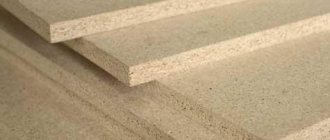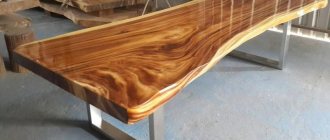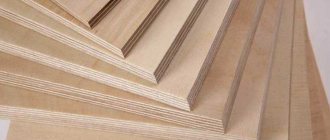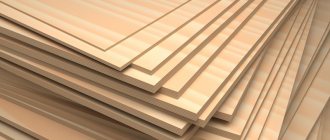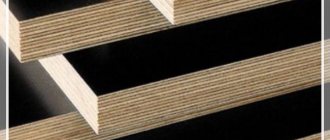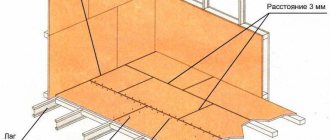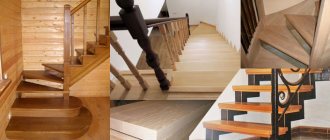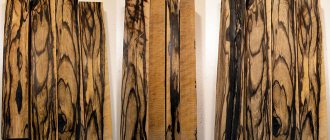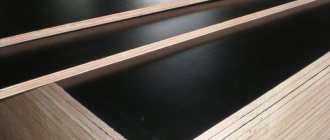In the modern building materials market, various sheet finishing materials are presented in a wide range.
These are chipboard and OSB boards, various types of plywood, plasterboard and other modifications. Despite this, the DSP board, the use of which is not limited only to interior work, deserves special consideration. The unique structure of the material, which consists of seemingly incompatible ingredients, provides DSP with characteristics that are not only not inferior to analogues, but also superior to them in some respects. Relatively low cost, strength and reliability, weather resistance and ease of installation make the material indispensable for any construction and repair work.
In most cases, for the installation of DSP boards, the use of a wooden or metal frame is necessary, so it is worth stocking up on the necessary material and fasteners in advance.
Types of cement bonded particle boards
All types are made by analogy.
They are first pressed and then fermented. The composition includes 65% cement, 24% wood chips, water and additives for cement mortars. DSP does not contain glue or resin. Fibrolite
Arbolit
Fibrolite
For production, shavings are used in the form of long strips, which are planed along the grain. It is very easy to work with such a sheet; it is quite soft during installation, but at the same time resistant to external factors and highly durable. Such properties are achieved due to the presence of inorganic binders in the composition. The fiberboard is impregnated with liquid glass and a solution of calcium chloride is applied. The weight of one sheet is small, and the thickness is up to 15 cm, so no lifting machine is required during installation work. Indoors, fiberboard is used to soundproof walls. The material is crack resistant.
Arbolit
Consists of lightweight concrete containing rice straw, shavings and shredded wood. The disadvantage of wood concrete is its heavy weight, rapid deformation and low strength. It is recommended for use in those structures that are not subject to special loads, for example, wall partitions. Wood concrete is often used in private construction and for thermal insulation of premises. This material retains heat well, however, it is not very resistant to moisture, so if it gets wet often it begins to deteriorate.
Xylolite
It differs in that it contains a special admixture - Sorel cement. This magnesium binder increases the product's resistance to water.
Xylolite is sheathed on the roof and floor in rooms with high humidity. It is used both in private construction and in the construction of public buildings.
The advantages of xylolite are high strength, high-quality thermal insulation and a wide color range. The material is fire-resistant, but with prolonged open fire it begins to char.
The xylolite sheet can be planed and cut, it can be sawed, painted, or impregnated with paints and varnishes.
What is DSP
Wood board containing cement is used in almost all areas of construction. Technical characteristics indicate the many advantages of the material:
- strength and moisture resistance;
- promotes sound and thermal insulation;
- easy to use;
- resistant to mold formation;
- suitable for various types of finishing (varnishing, plaster, ceramic cladding, etc.);
- the presence of wood chips allows you to withstand temperature changes;
- not susceptible to damage from rodents and insects.
The boards do not contain any impurities that may be harmful to health.
Types of DSP
DSPs have several varieties:
- In the form of a heat-insulating material containing long-fiber shavings (“wood wool”). This material is called fiberboard. It is soft, easy to process, biologically stable.
- A material containing sawdust and small shavings is called wood concrete. It is used for various purposes - as thermal insulation, finishing, partitioning, etc.
- The use of slab or cast xylolite, which has high strength and thermal insulation properties, is aimed at the production of floor coverings. The material has a wide range of shades.
How to prime DSP
Before proceeding with the final finishing of the surface of CBPB, it must be treated with a primer, preferably of deep penetration. For interior work, you can use the time-tested primer Ceresit ST 17, but its cost is quite high. There are other deep penetration acrylic compositions that are not much inferior to CT 17 in quality, and their cost is noticeably lower.
You can make a primer yourself by carefully dissolving 1 kg of PVA glue in 10 liters of water. This mixture is significantly inferior to deep penetration primers, but still better than nothing.
To treat façade cladding made of DSP, the use of a special primer is mandatory, otherwise the painting will end in disaster very soon. As a primer, you can use a 10% solution of acrylic facade paint.
Production of material
The plate manufacturing technology includes a number of successive stages:
- Components are being prepared. For this purpose, wood raw materials are cleaned and crushed. The resulting chips must be smooth and of the required size.
- Natural products contain substances that prevent high-quality adhesion (sugars, resins), so initial treatment is carried out with special mineral additives.
- The resulting mass is mixed with Portland cement and water to the desired consistency. Take into account that all components that must be included in the composition have clear proportions.
- Using special equipment, a sheet is formed that corresponds to the specified parameters. Most often, the large fraction of chips occupies the middle of the slab, and the small fraction is located along the edges.
- The resulting product is put under a cold press, where it takes shape under great pressure. By adjusting the amount of mass used and the degree of compression, the desired thickness is obtained.
- Temperature exposure is used as an additional treatment. After this, the panel enters a special workshop, where it is kept for 2 weeks until the required parameters are achieved.
Modern production is constantly developing, so it is possible to produce CBPB sheets with a minimum thickness of 6 mm without loss of properties.
DSP board – application in thermal insulation measures
When solving problems of thermal insulation of buildings, the DSP board is used as a cladding material.
Its fastening is carried out using hardware. Sheathing is done from different sides:
- outside the building using pre-installed sheathing or special mastic;
- indoors on a wooden or metal frame, as well as on the surface of the walls using glue.
Decorative finishing can be carried out immediately after completion of installation activities.
Slab certification and composition components
The smallest thickness of the slabs is 4 mm; accordingly, the weight of such products allows them to be used in high-rise buildings. The production of ultra-thin CBPBs has been developed in order to reduce the cost of the product, since thin sheets produced using modern technologies do not need to be brought to the required quality using grinding equipment.
There are also embossed boards with a smooth surface - they contain finely dispersed substances. Such slabs are used to decorate facades “like facing bricks” or “like natural stone.” Embossed sheets do not need to be further treated with special substances or primers, painted or sanded - they are ready for installation immediately after purchase.
| Parameter | Numeric value |
| Specific Gravity | 1250-1400 kg/m 3 |
| Humidity of the composition | 9+/-3% |
| Swelling per day, ≤ | 2% |
| Water absorption per day, ≤ | 16% |
| Bending strength: Product thickness 10,12, 16 mm ≥ | 12 MPa |
| Product thickness ≥ 24 mm ≥ | 10 MPa |
| Product thickness ≥ 36 mm ≥ | 9 MPa |
| Perpendicular tensile strength ≥ | 0.4 MPa |
| Flexural elasticity ≥ | 3500 MPa |
| Viscosity | 9 J/m2 |
| Flammability | G1 |
| Frost resistance after 50 freeze/thaw cycles ≤ | 10 % |
| Roughness Rz according to GOST 7016-82 ≤ For unpolished surfaces | 320 mm |
| For sanded surfaces | 0 mm |
| Maximum and minimum thickness deviations ≤ For ground surfaces | ±0.3 mm |
| for unpolished products with thickness: | ±0.6 mm |
| 12-16 mm | ±0.8 mm |
| 24 mm | ±1.0 mm |
| 36 mm | ±1.4 mm |
| Maximum and minimum deviations in length and width | ±3 mm |
| Thermal conductivity | 0.26 W/(mK) |
| Linear expansion | 0.0235 or 23.5 mm/(linear meter C) |
| Vapor permeability | 0.03 mg/(m h Pa) |
We advise you to study - Is it possible to lay linoleum on linoleum - when is this possible, and when is it not advisable?
When laying DSP sheets on the floor, you do not need to finish the resulting surface - it will be smooth enough to lay linoleum on it or paint it. Before painting, it is recommended (but not required) to prime the cement-bonded particle board or cover it with a special water-repellent compound. The appearance of such slabs will meet any design requirements.
It is important to carry out high-quality and correct installation of the sheets so that during operation they do not become loose, warp or begin to peel, which will reduce their service life. This is especially true for outdoor conditions of using CBPB boards
The wide range of applications of DSP is due to the competitive cost of this building material. Despite the low price, the quality of the products does not suffer, allowing the use of DSP in any conditions to solve a wide range of problems. So, when laying DSP boards as a subfloor, they will also serve as an additional layer of thermal insulation, in addition to a strong and durable base for a decorative floor covering.
Installation and finishing work of DSP
Before using CBPB slabs in construction, they must be delivered to the construction site, and this is done only on the edge. The sheets are stored horizontally and secured to the installation site in at least 3 places with press washers, for which holes must first be drilled. One of the disadvantages of cement-bonded particle boards is fragility, so they should be handled carefully.
The easiest way to finish slabs is by painting them with silicone, acrylic, or water-based paints. When installing between adjacent slabs, an air gap of 2-3 mm must be left to compensate for the expansion of products with changes in temperature and air humidity. The air-tight and smooth surface of the slabs allows the application of protective paint without prior priming of the surface, on the side of the slab on which the cement layer is located.
Joints and gaps between slabs cannot be puttied; it is permissible to use sealant to mask the seams, since it does not crack from exposure to precipitation and temperature. It is also recommended to seal seams and joints with wooden slats or metal strips
The finishing of DSP walls is facilitated by their absolutely smooth bottom surface. Panels mounted outside or inside the house can be finished by plastering, painting, laying porcelain or tiles, wallpapering, laying linoleum, laminate, carpet, etc.
In the building materials market, cement particle board, whose technical characteristics compete with traditional materials, costs almost the same as other board products, depending on the dimensions, weight of the product and the volume of the order.
To decorate the walls of a house, they often use the technique of decorating with red or finishing bricks. Such an exterior of a private house will give the home respectability with minimal financial and labor investments.
Description and characteristics
Cement particle board ( CSB ) can be very useful in construction and repair, being used quite often for finishing the walls and floors of frame structures. Such material is a leader in many respects on the modern market.
It will be a very advantageous option when used in ordinary living rooms and public spaces, but especially where the humidity level is constantly higher than normal: in bathrooms, showers, kitchens, swimming pools.
Such slabs can also be irreplaceable when arranging facades and paved paths; as a thermal and sound insulator; for the construction of window sills, canopies and other similar structures.
DSP board is a multicomponent material produced in a factory by pressing and subsequent fermentation. A mixture of various materials is used as components of the composition:
- Portland cement is the main one, containing about 65% of the total volume;
- wood shavings are the second most important component (24%);
- During manufacturing, various minerals are also added as binders;
- other chemical ingredients and water.
This composite material ultimately takes the form of sheets of various sizes that meet government standards. The resulting building element, which has been relevant for a number of decades, has quite a lot of positive properties. Let's list the most important of them.
1. Multifunctionality. The use of slabs is multifaceted: they are perfect for decorating rooms for various purposes; there are special slabs for flooring; DSP is widely used for the construction of internal partitions of rooms.
2. Environmental friendliness. The boards contain only safe substances. The release of harmful vapors and elements into the atmosphere during production is completely eliminated.
3. Large selection of material parameters. The sizes of the CBPB board are widely presented in the assortment. Modules of 3200x1250 mm are considered standard. But significant deviations are allowed depending on the thickness of the sheets, which can be from 8 mm and much higher. If the last parameter is large, it is also possible to change the length and width upward.
4. All products have a quality passport, certificates and comply with GOST. Therefore, when purchasing products from a large manufacturer, there is no doubt about their quality.
5. In accordance with accepted norms and standards, the material is significantly protected from fires and severe frosts. It cannot attract rodents and smaller pests as a source of food: insects, parasites, fungi; noise insulation of the material is expressed in a digital value of up to 30 dB.
6. Durability. Although externally similar to wooden structures, the material is more reliable. Therefore, most often, it is preferable to wood. This indicator is ensured by a three-layer structure. The outer layers, located on both sides, consist of small chips. The internal contents contain stronger formations.
Here we should also add the smoothness of the material, its resistance to moisture, ease of installation and affordable prices, the ability to operate in difficult conditions. A separate disadvantage of the plates can be considered a short service life in a particularly aggressive environment. But it is also about one and a half decades. However, by creating additional protection, it is possible to significantly extend the quality life of the material.
Types on sale
Like any types of building materials, DSP boards have a number of varieties. Their subtleties relate to the production aspect, since these plates look different, are used in different industries, and have unique features.
The first option is fiberboard. The base used here is not wood shavings, but fibers, which makes the base viscous and especially tensile. To achieve additional strength, liquid glass and calcium chloride are used at the production stage.
Thanks to their resistance to damage, the products are not only able to withstand heavy loads, but also resist the effects of sound. That is why fiberboard is often used as sound insulation in studios, shopping centers, bars, and discos. Despite these properties, fiberboard is easy to process yourself. To do this you do not need to have any special tool. It is easy to process even at home.
1. Wood concrete. This is the second version of the variety. Here sawdust is used as a wood binder. Rice straw and reeds are used as the production basis. Among all the raw materials used for production, wood chips provide the highest strength.
The performance characteristics here are lower than those of the above option, but the cost of such a product is also cheaper. As for the total weight, the sheets are heavier, but suitable for walls. That is why they are used to decorate low-rise frame houses of private construction.
Production of CBPB boards
2. Xylolite. This is the third variety. The strength of such products is so high that they can be used for both floors and walls. Lumber, namely wood chips, is used as the basis for production. On sale you can find not only the colors of the standard segment, but also various shades, which turns out to be quite profitable in terms of finishing. Sometimes they are even left without additional cladding, because against the background of the overall interior they look interesting and expensive.
Choosing cement sheets for the floor
The choice of DSP boards is carried out in accordance with the conditions in which the material will be used, as well as the technology by which its installation will be carried out. For laying on logs, slabs with a thickness of 20-26 mm are used - they will perfectly cope with their function as a rough base. If installation is carried out directly on the ground, then 24-26 mm slabs are used. In general, almost any DSP board can be used to level floors.
Average market prices for material
On a note! DSP boards can be laid even in cold weather. It doesn’t matter if the air temperature outside the window drops below zero.
Requirements for CBPB slabs used for floor installation:
- humidity – from 6 to 12%;
- density – more than 1300 kg/m3;
- tensile strength – 0.4 MPa;
- surface roughness – 80 microns;
- moisture absorption level – 16%.
For the floor, DSP boards must be used that meet a number of requirements
Varieties
Classification of DSP:
- Arbolite. Universal, homogeneous, contain fine chips. They belong to lightweight concrete and are used for cladding facades, formwork, erecting partitions, and creating a base for floors. There are decorative types, embossed, painted to resemble stone or brick, which do not require additional coating.
- Xylolitic. These are plates of increased strength, with a high level of thermal insulation. They are used to cover floors. The wood chips are quite large and are located in layers in the inner part of the canvas.
- Fibrolite. In the process of their production, long coniferous chip fibers are used, which contain a minimum amount of sucrose and other organic substances that affect cement. The slabs have a softer texture and high sound insulation. Fiberboard is suitable for interior work: installation, insulation of walls, construction of a base for ceilings.
Outdoor use
For the construction of formwork, facades, and fences, materials with maximum moisture resistance are chosen. DSPs are best suited for creating strip foundations.
The thickness of the slabs for external work is 12–40 mm. The service life of finished structures depends on weather conditions: amount of precipitation, difference in seasonal temperatures. On average it is about 15 years.
For external work, it is optimal to choose materials with an additional protective layer of moisture-resistant polystyrene foam and stone chips.
Before installing the formwork for the foundation, crushed stone is laid on the ground, then a layer of waterproofing. A footing is poured on top, structural pins and drainage are installed.
When installing slabs, use tin ties, fasten them at the top and bottom of each sheet, at the corners and in the middle. This provides additional stability to the structure. The distance between the rows of lintels should be about 40 cm. All wood blanks are immediately removed after the concrete has hardened.
The seams are sealed with cement mortar.
To lift and secure the slabs at the required height, winches and stable scaffolding are required.
Formwork made from DSP is installed several times faster than from wood and other materials, and the results are much better.
Interior finishing and flooring
For interior work, sheets with a thickness of 4 mm or more are used. Slabs from 8 mm are suitable for rough and finishing installation of floors. It should be taken into account that the thermal insulation and noise-absorbing qualities of thicker sheets are higher.
Tools required for work:
- saws or hacksaws;
- spatulas;
- self-tapping screws;
- screwdriver;
- building level;
- tamping roller or picking blade;
- crushed stone, mastic, primer.
When installing slab floors, the base is pre-prepared
. To do this, it is leveled and a layer of crushed stone is poured. If the subfloor is made of concrete, a substrate is laid on it or support joists are installed. Thermal insulation is placed in all existing voids. Bulk materials are preferable because they do not require cutting.
The slabs are mounted end-to-end, trying not to leave gaps or cracks. The seams are treated with sealant
. If materials with low moisture resistance are used, an additional layer of waterproofing is laid underneath them. Then the finishing coat is applied.
DSP on the floor: how to use
It is recommended to make a DSP floor from slabs with a thickness of at least 20 mm. Theoretically, slabs of this thickness can be laid on joists, but it is better to keep the installation step small. On a solid, level base (concrete screed or subfloor), thinner sheets can be used, but the thermal insulation and sound insulation characteristics will be lower.
Dependence of the thermal insulation coefficient on the thickness of the slab and the weight of one sheet of different thicknesses
As a base for laying a finishing coating, this is one of the good options. You can lay both soft (linoleum, carpet, PVC tiles, cork) and hard (laminate, parquet, parquet boards) coatings. Placed on DSP and tiles. In this case, take cement-based glue and make sure that the base is stable and there is no movement. When laying out, try to ensure that the seam of the tile does not fall on the junction of two sheets.
Under hard coverings (in particular under tiles), you can lay DSP not along the walls, but diagonally. Thus, when laying straight, you will definitely avoid matching seams. There is more fuss with laying the slabs this way, but the load on the seams will be lower. There is less chance of cracks at the seams or breaking of the tiles, swelling of the laminate seam.
Cement particle blocks
Arbolite or cement-bonded particle blocks are an excellent material for the construction of buildings. Such blocks belong to the category of lightweight concrete. They contain mineral binders and fillers, for example, waste from the sawmill and woodworking industries, as well as organic cellulose raw materials and water.
Arbolite combines the characteristics of cement stone and wood, it has excellent performance. It does not rot, is highly fire resistant and easy to use. Such blocks can be used to construct buildings up to 3 floors high.
Wood concrete blocks contain 80–85% wood filler, for example, wood chips, crushed pieces or shavings from 2 to 25 mm long, 5 mm thick), as well as high grade cement, most often PC500.
Today, the most popular raw material for creating cement-bonded particle blocks and boards (CSB, CSP) is pine chips, but GOST 19222–84 allows the use of other wood processing waste (from deciduous and coniferous varieties). But still, it is from pine or spruce shavings that the highest quality blocks are obtained, since these varieties contain the lowest amount of organic component (sucrose) that needs to be neutralized. Chips for CSB need to be dried and the surface mineralized using a solution of chemical components that eliminate sucrose. This prevents wood from rotting and becoming infected with fungus during use. If any other additives and materials are used (sand, plasticizers, hardeners), then the material cannot be considered a real wood concrete.
How to seal DSP joints
Since cement particle board has thermal expansion, the boards are not laid close to each other, but with a gap. Under hard flooring, the joints do not need to be sealed (open seam). The seams must be on the base (beam, joists, sheathing), so the joint will not be empty. For better insulation, a strip of waterproofing material is laid on the beam with an open seam. This can be thick polyethylene film, roofing felt or more modern waterproofing materials.
How to seal DSP joints on the floor
If the floor is made from DSP boards under a soft floor covering, the seam is filled with an elastic sealant. When choosing a sealant, make sure that after drying it remains elastic, otherwise it will simply crumble and sag. It must also be compatible with wood and cement. Copolymers are the best in this regard, but they are expensive.
There is another option for filling the joint between DSP boards on the floor - an elastic cord made of polyethylene foam. It is laid in the gap, and the top can be sealed or painted.
Advantages and disadvantages
Advantages and disadvantages are important at the time of choice. They are worth considering, but you need to familiarize yourself with them first. Let's start with the advantages:
Wide range of applications. This makes them multifunctional, since today sheets can be used for interior and exterior work. You have previously become acquainted with the scope of application and understand that they cover the entire range of construction of private and permanent houses. Covers a large area. By cutting just a couple of sheets, you can easily finish a fairly large area, about 8 square meters. The material is easy to process, so even if you do not have a specialized tool, you can always cut it into the necessary parts manually. The manufacturing process is quite complex, but no toxic harmful substances are used here. There is cement, wood, special glue, water and plasticizers. You can see for yourself that the material does not in any way spoil the surrounding atmosphere, does not violate the internal aesthetics of the premises and does not in any way affect people’s health from a negative point of view. Can be finished with modern materials
We advise you to study - The best laminate manufacturers in terms of quality and wear resistance
This can be not only wood and wallpaper, but also paint, which is important for a material with a similar structure. Its high noise insulation properties make it possible to maintain comfort in homes, as well as hide particularly noisy objects from strangers.
Today, there are not only gray DSP boards on sale, but also those that were originally finished with brick, ceramic tiles and other finishing options. All this allows you to inexpensively cladding your own house, bathhouse, garage and other buildings.
There are practically no disadvantages. Unless this includes the large weight of the CBPB board. This involves deepening the foundation, since the load on it will be large. During the installation process, it is necessary that the fasteners be galvanized or processed in a special way. Therefore, think about this moment in advance.
Objects using DSP
Sheets of cement building boards are most often used in the following objects:
- buildings for offices;
- industrial enterprises;
- healthcare institutions;
- hotels;
- schools;
- kindergartens;
- frame-type residential buildings up to three floors inclusive;
- gyms;
- warehouses;
- hangar premises.
In addition to the main areas of application of DSP panels, they can be found in the arrangement of the following objects:
- when arranging window sills and erecting fences;
- when covering balconies and finishing fireplaces, chimneys;
- when creating a ventilated facade, as well as its insulation;
- as a covering for the roof and as a base for the floor.
Also, such slabs are an excellent material for the construction of outbuildings: garages, outdoor toilets, barns, bathhouses, cellars. With the help of these sheets, resistance to high humidity and precipitation occurs.
Where are DSP panels used?
Material made from cement and wood chips is a high-strength construction base with good environmental friendliness and sustainability. It is widely used in the construction and reconstruction of civil, industrial and agricultural facilities.
DSP sheets form an excellent basis for modular construction. With their help, heat-saving and sound-absorbing walls are created in frame houses. The slabs perfectly level the base of the floor and make it warm, which significantly increases its service life. Dimensional accuracy facilitates faster installation of panels into the frame.
It is advisable to use such slabs in the construction of permanent formwork, fencing, and facade finishing. This greatly reduces work time, provides structures with the necessary reliability and saves overall construction costs.
Advantages and disadvantages of DSP panels
The main advantages of using the material:
- high strength;
- absence of toxic and carcinogenic components;
- thermal protection;
- moisture resistance;
- resistance to biological aggression, insects and rodents;
- good sound insulation;
- operation in various climatic conditions;
- acceptable cost.
Feedback from experts confirms the small number of shortcomings of DSP panels.
- Large mass complicates the transportation and installation of elements, which somewhat slows down the work process.
- Brittleness when bending - a smooth base is required for laying slabs. It is advisable to buy building material with a reserve of 10-15% more than planned by the estimate.
- Limited service life - only valid under severe operating conditions.
Negative aspects lead to a slight increase in the cost of construction work.
What is a CBPB board, composition
DSP board is a sheet material for exterior and interior decoration. Can be used on walls, ceilings, roofs, as a subfloor, or as a base for flooring. The composition of CBPB is wood shavings and cement with additives.
- Portland cement grade M500 – 60-65%;
- wood (wooden) shavings of medium and fine fraction – 24-25%;
- water – 8.5-10%;
- additives (calcium chloride, aluminum sulfate, aluminum sulfate, aluminum chloride, sodium silicates) – 2-3%.
The DSP board is formed from three to four layers. The inner layers in CBPB are made of longer sawdust (sawdust thickness 0.2-0.3 mm, length 10-30 mm), the outer layers are made of smaller ones. The inner layer serves to impart strength and elasticity, while the outer layer makes it possible to make slabs with a smooth surface that requires minimal finishing. The formed sheets are fed into a press, then dried to normal humidity (10-12%).
Advantages and disadvantages
Let's start with the positive aspects of the material:
- This is an environmentally friendly material that, under the influence of changing humidity and temperature, does not emit substances harmful to humans;
- the slabs withstand the most severe frosts well: they do not crack or delaminate;
- good moisture resistance indicators allow them to be used when facing any types of surfaces;
- sufficiently high load-bearing performance;
- DSP boards can be used in combination with any other building materials;
DSP sheets are very easy to drill
- they are easy to process: drilling, sawing;
- ease of installation work;
- the possibility of finishing the sheets themselves with any materials;
- using DSP sheets, leveling operations are carried out;
- Based on their thermal insulation properties, they can be classified as thermal insulation materials.
The best option for finishing the DSP boards themselves is painting
Now the disadvantages:
- The weight of the DSP boards is decent; even a small sheet of 10 mm thickness weighs more than 50 kg. It is beyond the power of one person to lift it and install it where required. And lifting material to the upper floors will require the use of lifting equipment, which increases the cost of the work performed.
- If CBPB panels are used outdoors, their service life is reduced to 15 years.
The weight of cement-bonded particle boards is large, so it will take two people to lift it
DSP board: sizes and prices
Regardless of the brand, TsSP-1 or TsSP-2 (GOST 26816-2016), the sheet size can be:
- Thickness: 8-40 mm, in 2 mm increments;
- Length: 2700/3200/3600 mm;
- Width: 1200/1250 mm;
Depending on the thickness and overall dimensions, the weight of the sheet can vary significantly:
| Overall size, mm | Weight, kg |
| 3000x1250x8 | 41.7 |
| 3000x1250x10 | 52,1 |
| 3000x1250x12 | 62,3 |
| 3000x1250x16 | 83,1 |
| 3000x1250x20 | 104,3 |
| 3000x1250x24 | 124,7 |
| 3000x1250x26 | 142,1 |
The table shows that thick CBPB sheets have a significant mass, therefore, when working with them, it is advisable to use various lifting devices.
Installation features
The slab can be secured to the frame using self-tapping screws or nails. The selection of fasteners is carried out as follows:
- For self-tapping screws, take a thickness of 2.5 mm. The heavier the sheets, the thicker the screws are selected. The length is determined by the thickness of the “pie” with which the frame is sheathed. Before screwing in the fasteners, use a drill to drill holes for the screws.
- For nails, selection of length and thickness is done according to the same principle. The wood must accommodate at least 10 nail diameters to ensure a secure fit.
The DSP board weighs a lot, so in order to securely fix it to the frame, it is extremely important not to skimp on fasteners. The table shows the recommended number of fasteners for various sizes, as well as the maximum allowable distance between them.
The sheet is fastened around the perimeter, with strict adherence to the vertical placement of the slab and the frequency of installation of fasteners. After the sheet is secured around the perimeter, it is also necessary to tighten it along the line that runs in the middle of the height of the slab (horizontally). On this line it is permissible to screw in screws half as often as along the perimeter.
Laying CBPB on the floor
If the slab is used to create a subfloor, the technology involves placing a joist system. Timber is used for the logs (its dimensions: width 5 cm, thickness 8 cm). The logs are placed on the base, having previously laid a layer of sound and waterproofing. The step between the logs is about 0.6 m.
A layer of insulation is placed between the joists. The thickness of the layer is selected so that after laying and covering with a waterproofing membrane, the layer is a couple of centimeters deeper than the joist. This gap is necessary to organize ventilation.
A DSP board (usually 2 cm thick) is placed on the logs. The slab is attached to the joists with self-tapping screws, recessing the countersunk heads flush with the floor surface. The seams are carefully sealed using sealant. The finished floor can now be laid on top of the slab.
Application area
If we talk about the advantages of DSP, first of all it is worth mentioning the non-flammability of the material. It is not flammable and does not support combustion. The second positive point is the absence of synthetic components that emit styrene and formaldehyde. This explains the popularity of this material in frame housing construction. Even despite the considerable weight of the slabs, they are used to cover the first and second floors.
Scope of application of DSP boards - walls, ceiling, floor, formwork
DSP board is also used for the floor. But it is worth saying that the material has an unstable geometry. This is explained by technological features. So it’s difficult to get a perfectly flat surface without “steps” between the sheets.
Second point. DSP boards are plastic. In the sense that if they are laid on an uneven surface, over time they will take the shape of the surface. On the one hand, this is good - where some sheet materials on uneven floors may break, the DSP will simply repeat the shape. On the other hand, you can’t even put a thick sheet on joists with a large distance - it will sag over time. On a subfloor or other base with minimal gaps, it can be used without problems.
Negative aspects of building material
The disadvantages of DSP include:
- Heavy weight. The slabs have to be delivered by special transport, and for installation you need to look for at least 1 assistant. To lift the sheathing to the upper floors you will need winches and scaffolding. The load on the foundation increases.
- Low resistance to bending forces. This limits the scope of application of the slabs. For example, they cannot be laid on joists without a durable intermediate filler between them.
Among the disadvantages is the complexity of processing: a diamond or carbide tool is required.
Frost resistance
Cement particle board absorbs a small amount of moisture, so the risk of destruction when exposed to negative temperatures is low. The product can withstand 50 cycles of freezing and heating. In this case, there are no visible damages, and the strength remains at 90%.
These properties allow the material to be used for those rooms in which heating is not provided. However, you will have to additionally protect the panels from moisture accumulation. For this, a special primer or waterproofing materials are used.
Production Features
DSPs are manufactured in the following order:
- Using special machines, wood waste is cut into chips.
- It is treated with calcium chloride and aluminum sulfate. This is necessary to destroy polysaccharides that impede the setting of cement.
- Using mechanical sieves, chips are sorted into large and small.
- Mix each fraction with cement, water and hydration additives. To reduce the friction force between the chips during pressing, add fuel oil or I-20 oil.
- Load the mixture into molds in 3 layers so that there are large chips inside the slab and small chips outside. This is done in order to reduce unevenness on the surface.
- Weigh the form. If the standard value is exceeded, the material is removed from the pallet and subsequently used to fill the middle layer. This operation ensures high accuracy of parameters and adherence to technology.
- The mold is placed under a cold press, developing a pressure of 1.8-6.5 MPa. The load becomes 3 times thinner.
- The form is fixed in a compressed state with special locks and removed from the press.
- Next, it is sent to the oven and heated there for 8 hours. The elasticity of the wood compensates for the shrinkage of the cement, and the dimensions of the slab do not change.
- The mold is returned to the press and the locks are opened under pressure.
- The slab is coated with lubricant and sent to a buffer warehouse, where it is blown with air heated to +100°C for 2 weeks.
- Finally, the CBPB is cut to the size established by GOST.
DSP is treated with calcium chloride.
Application
When purchasing cement particle boards, the use of such material must be thought out in advance. The dimensions of the material allow you to cover a large area of the room at once and quickly level the surface. Not only residential buildings are built from DSP, but also sheds, garages, and utility rooms.
The scope of application depends on the thickness of the product:
- 1-1.6 cm. These are the thinnest versions of this material. They are used for cladding walls on the inside and outside. The product is also suitable for arranging internal partitions not only in living rooms, but also in the bathroom, toilet, and kitchen. They are also used in the manufacture of fireproof doors and balcony railings.
- 1.6-2.4 cm. Such sheets are suitable as a base for a roof. In this case, you need to use soft material to finish the roof.
- 1.2-2.4 cm. Used in low-rise construction for the construction of permanent formwork for the foundation. If the slabs are additionally treated with painting or adhesive waterproof materials, they will act as vertical waterproofing.
- 2.4-3.6 cm. They are suitable for the manufacture of window sills, internal partitions, and roof construction.
The use of such material depends not only on the thickness of the sheets, but also on their physical properties.
Cladding of walls and partitions
For walls, DSP is used as insulation and sound insulator. They can also be used to quickly level the base for subsequent finishing. They are used to decorate both massive and frame walls. They can be mounted on brick bases instead of a layer of plaster.
For insulation, you can use slabs whose density is 250-350 kg/cubic meter. m. Fiberboard is considered more suitable, since it contains less cement. This material is strong enough to be attached not only with glue, but also with anchor bolts (nails).
If the surface of the walls is flat, then a frame is not required to fix the DSP. For additional protection from moisture, a thin layer of plaster or water-repellent paint is applied to the surface of the panels.
Soundproofing properties are ensured not only due to the proportion of wood waste in the composition of the product, but also due to its shape. In this case, the joints between the sheets must be airtight.
For interior decoration, material with a density of 1000 kg/cube is suitable. m, external - 700 kg/cubic. m. If further cladding will be carried out using tiles, then it is better to use unpolished slabs.
To create a full-fledged wall or large partition, a supporting frame is required. You can do without it if the slab covers the entire opening and is fixed in the upper and reliable part. But such a partition will not carry a functional load, but will remain only a decorative element in the room. When using thick products, it will be possible to cut a door into them. The opening should not be wider than 1.5 m.
To cover the ceiling, you can use thin slabs that are attached with glue or anchor nails. But here you need to take into account the strength of concrete floors. And it is better to give preference to fiberboard.
Curtain façade systems
The use of DSP for the facade is justified by the performance characteristics of the material. The sheets protect its inner layers from the negative influence of precipitation, temperature changes and other negative factors. The product is resistant to mechanical stress. For cladding, light sheets are used, the density of which is 1100-1400 kg/cubic. m, and the thickness is 1 cm.
The advantage of the panels is the possibility of further finishing painting in any color. At the same time, the surface looks smooth. Manufacturers also produce panels that do not require finishing. They are already decorated to look like brick, chips or stone.
Roofing systems
The material is used for arranging flat roofs, even if they will be used. Before installing the DSP, insulation and waterproofing are laid on the base. Since the slabs are rigid, even when walking on the roof the insulation does not experience concentrated loads. Such properties make it possible to arrange a recreation area or a summer cafe here.
The advantage of DSP in this case is the absence of “wet” installation processes and the ability to quickly process a large area in any season of the year. The slabs perform well in regions where there is an increased snow load.
Floors
Floor slabs are laid on rough flooring or concrete screed. The second option is required if the base is uneven. The product can be used not only in living rooms, but also in the bathroom. For finishing, ceramic tiles, parquet, laminate or linoleum are used. But additional waterproofing is required. The optimal sheet density in this case is 500 kg/cubic. m (for fiberboard - 900 kg/cubic m).
If the house is frame, and the slabs are laid on joists, then they should be thicker.
Installation of the basement floor is carried out as follows:
- Insulation and waterproofing material are laid on the support posts.
- Now the logs and bars are being installed. The placement step is 60 cm.
- The next stage is laying the plank flooring and thin cement bonded particle board.
- A waterproofing layer and insulation are again installed on top of this cake. The ventilation gap is taken into account here, so the thickness of the material should be 3 cm less than the depth of the log.
- Laying another DSP, which is fixed with self-tapping screws.
After this, the floor covering is installed. While working, you need to remember about the expansion joint. It should be located at the junction of the panel with walls, columns and other vertical structures. This material is often used to construct a floating floor. You can purchase the product not only in Moscow, but also in other regions.
Formwork
What DSP is is already clear, but it can be used not only for finishing foundations, but also as permanent formwork when building a house. This is facilitated by the high degree of rigidity of the slabs and resistance to moisture. This material provides high quality insulation for the base.
To prevent the solution from pushing out parts of the formwork, they must be fixed using jumpers around the entire perimeter. Particular attention should be paid to this if the pouring is carried out with heavy concrete.
Additionally, supports are used to prevent the sheets from moving. To make formwork, you should take sheets with a density of 1000 kg / cubic meter. m.
The greater the thickness of the DSP, the higher the thermal insulation properties. For maximum insulation, it is allowed to make double formwork. If the filling is made with foam concrete, then additional insulation is not required. Permanent formwork should not be made below the groundwater level, since constant exposure to moisture deteriorates the technical qualities of the material.
Garden paths
Additionally, DSP can be used for landscaping, greenhouses and garden paths. In the second case, installation is carried out on a well-compacted sand “cushion”. No swelling or cracks will appear on such a path.
For the arrangement, materials 2-3.6 cm thick are taken. As a result of the difference in soil and air humidity levels, the edges of the product may rise. You can avoid this problem by cutting the sheet into smaller pieces. You should not use products of large dimensions.
Criterias of choice
When purchasing a DSP, you should require a certificate. The document serves as confirmation that the slab was manufactured in accordance with the technology.
Popular manufacturers
The largest Russian manufacturers of CSPS include:
- Tambov "TAMAK".
- St. Petersburg "TsSP-Svir". The production is located in Lodeynoye Pole, Leningrad region.
- Sterlitamak plant of building structures. The enterprise belongs to the Ufa Holding Company "Bashbeton".
- "MIT Kostroma".
- Omsk "Stropan".
- Tyumen "Sibzhilstroy".
Tambov "TAMAK" is a large manufacturer of CBPB.
The Belarusian enterprise TsSP BZS (Krichev) also offers good products.
Approximate cost
The Kostroma TsPS plant sells panels measuring 3200x1250 at the following prices (rubles) with thickness:
- 10 mm - 1091.
- 12 mm - 1187.
- 16 mm - 1524.
- 20 mm - 1979.
Slabs of the 2700x1250 format are sold at the following price (RUB) thickness:
- 10 mm - 1206.
- 12 mm - 1581.
- 16 mm - 1612.
- 20 mm - 2575.
A DSP board from this manufacturer measuring 3200x1250x12 mm costs 1,736 rubles.
Fire safety
The cement component makes the slabs resistant to fire, so they can be used in the finishing or construction of buildings that will be operated in high temperature conditions.
The material has the following characteristics:
- poor flammability;
- difficult flammability;
- a small amount of smoke;
- no flame spread.
Since the product does not contain resins or adhesives, they do not release toxic components even when exposed to fire.
Main types
According to the level of requirements for the accuracy of geometric parameters, the material is divided into 2 types:
- TsSP-1 is of high quality.
- TsSP-2 - low.
Each category offers several grades that differ in strength and dimensional tolerances.
Based on the type of surface, there are 3 types of DSP:
- unprocessed;
- polished - do not require leveling before applying the finish;
- with decorative plaster or imitation brick or stonework on the front side.
They produce related materials, similar in composition to DSP.
Fibrolite
This building material differs from CBPB in the following ways:
- fibrous structure: long narrow shavings - “wood wool” - are used as filler instead of wood chips;
- low pressing pressure - 0.5 MPa versus 6.5 for CBPB.
Fibrolite is a construction board material.
This provides the following benefits:
- Reduced thermal conductivity to 0.08-0.1 W/m*°C.
- Improving sound insulation properties.
- Compliance when processed with cutting tools.
But due to the reduced density, fiberboard is inferior to DSP in the following:
- Frost resistance.
- Moisture resistance. The water absorption coefficient is 35%-45%.
- Biological stability. When humidity is more than 35%, it is affected by house fungus. For this reason, the material must be protected from dampness with plaster or waterproofing film.
Panel dimensions (mm):
- Length - 2400 and 3000.
- Width - 600 and 1200.
- Thickness - 30-150.
Less commonly, blocks are made from fiberboard.
Based on density and strength, the material is divided into grades:
- F-300 - thermal insulation;
- F-400 and F-500 - thermal insulation and structural.
The second type is used for the construction of partitions and frame walls.
Arbolit
Differences from DSP:
- In addition to wood chips, flax or hemp, rice straw, crushed reed or cotton stalks are used as filler.
- The share of organic filler reaches 80%-90%.
- The material is produced in the form of wall blocks.
Arbolite is a lightweight concrete based on cement filler.
Depending on the density, wood concrete is divided into 2 types (kg/cubic m):
- thermal insulation - 400-500;
- structural - 500-850.
Material characteristics:
- thermal conductivity coefficient - 0.17-0.7 W/m*C;
- compressive strength - 0.5-3.5 MPa (5-35 kg/sq. cm);
- frost resistance - 25-50 freeze-thaw cycles;
- water absorption - 40-85%.
Structural grades of wood concrete are used for the construction of self-supporting walls in buildings up to 3 floors high, while others are used for insulation of enclosing structures.
A water barrier is required on the street side; the permissible humidity in the room is 75%.
Xylolite
The material has the following features:
- Instead of wood chips, sawdust, shavings, hay, straw and other plant waste are used as filler.
- Magnesia cement with the addition of magnesium chloride is used.
Xylolite is a material consisting of a compressed mixture.
Xylolite is pressed under high pressure, as a result of which it acquires the following characteristics:
- density - 900-1400 kg/cubic. m;
- water absorption - 3% -5%;
- compressive strength - 5-50 MPa (50-500 kg/sq. cm).
Thanks to this, the material can be laid on the floor, incl. in damp areas. When struck, it does not crack, but only wrinkles.
Xylolite is produced in the form of slabs with a thickness of 7-40 mm.
